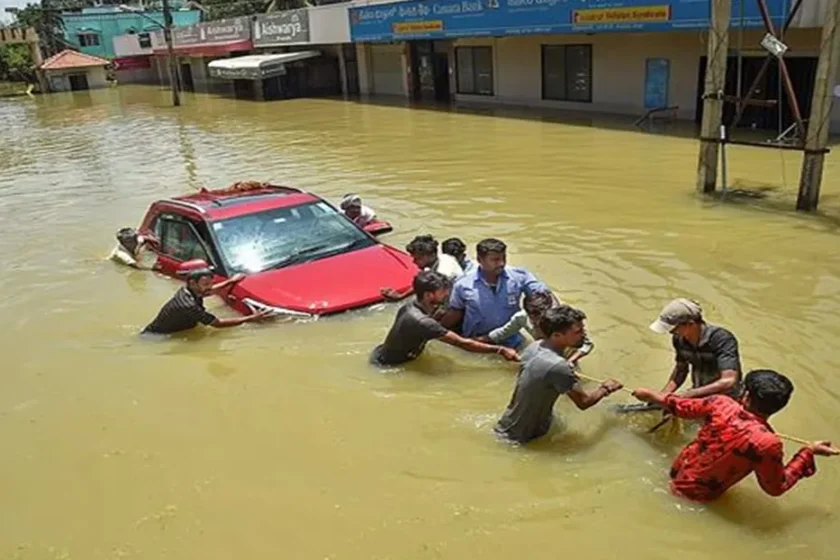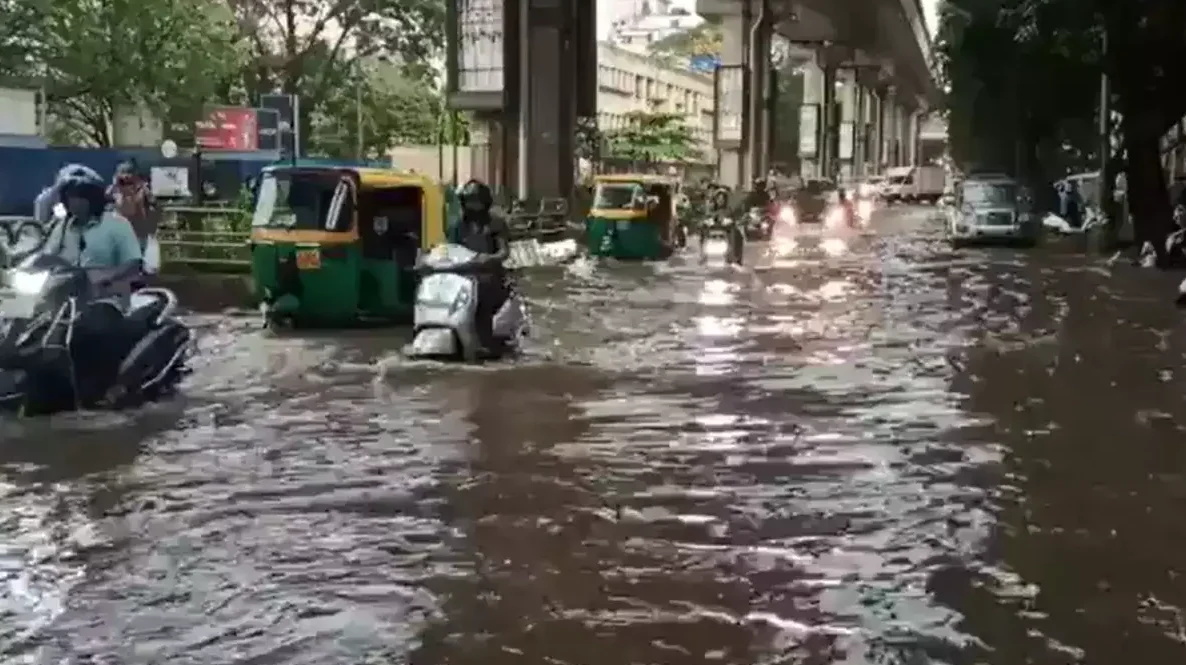Torrential Rain in Bengaluru Causes Havoc: Viral Video Shows Flooded Apartment Complex, Lives Lost
In the early hours of Monday, Bengaluru was once again battered by heavy rain, which led to severe flooding in various parts of the city. The torrential downpour, which lasted through the night, wreaked havoc, causing significant waterlogging, disrupting daily life, and even resulting in tragic casualties. Videos of the devastation spread rapidly on social media, with one particular clip going viral. This video captured scenes of a flooded apartment complex near Yelahanka Lake, where vehicles were submerged in neck-deep water, effectively halting any movement for the residents.
The widespread flooding serves as a grim reminder of the challenges posed by urban development and the increasing frequency of extreme weather events. As the rain continued to pour, the city found itself in a state of crisis, with emergency services stretched thin, trying to address both the immediate effects of the waterlogging and the tragic consequences of the storm.
Viral Video of Yelahanka Lake Flooding
One of the most striking visuals of the Bengaluru floods came from an apartment complex located near Yelahanka Lake. The viral video, shared across various social media platforms, showed rows of vehicles nearly completely submerged by the floodwaters. The footage depicted the chaotic aftermath of the heavy rains, with water reaching the ground floors of the building, making it impossible for residents to evacuate or even assess the full extent of the damage.
The water from Yelahanka Lake, which overflowed due to the torrential rain, was primarily responsible for the flooding. This event highlighted a growing problem in Bengaluru—urban encroachment on natural water bodies. Lakes that once helped manage excess rainwater have increasingly been encroached upon or neglected, leading to dangerous flooding in areas like Yelahanka.
The video has attracted significant attention, with one user on “X” (formerly Twitter) posting: “Yelahanka Lake is reminding Kendriya Vihar that apartment is on its land. After last night’s torrential rains, today’s scene. Time to demolish it and reclaim the lake property. Whoever has built it has to pay compensation to house owners.” This post, along with the video, has received over 87,000 views, sparking conversations about poor urban planning, the encroachment on lake lands, and the long-term risks to residents of such areas.
Several other users chimed in on the debate, with one pointing out that the complex was a cooperative housing project built for former central government employees. Another user noted that the project had been developed by the Public Works Department (PWD) of the central government, calling on Prime Minister Narendra Modi to intervene and provide alternative housing solutions for the ex-servicemen living there. The debate reflects the growing frustration among residents and citizens alike, who are increasingly critical of the city’s infrastructure and the lack of accountability in urban planning.
Tragic Drowning of Two Children in Kengeri Lake
The heavy rains not only caused property damage but also claimed lives. In a separate, heartbreaking incident, two siblings tragically drowned in Kengeri Lake while attempting to collect lotus flowers. Thirteen-year-old John Srinivas and his eleven-year-old sister Lakshmi were swept away by the strong currents. On Tuesday, rescue teams recovered John’s body, but the search for Lakshmi continued.
The two children lived in the Kengeri area of Bengaluru, and their mother, Nagamma, works as a sanitation worker with the Bruhat Bengaluru Mahanagara Palike (BBMP), the city’s municipal corporation. The loss of the children has left the community devastated, and their deaths have raised serious concerns about the safety of urban water bodies, especially during periods of heavy rainfall.
Urban lakes, which once served as essential catchment areas for rainwater, are now frequently overflowing due to neglect and encroachment, creating dangerous conditions for those who live nearby or use the lakes for recreational purposes. The tragedy of the two siblings has prompted discussions about the need for stricter safety measures around lakes and water bodies, especially during the monsoon season.
IMD Issues Alerts for Continued Heavy Rain
The India Meteorological Department (IMD) had earlier issued an orange alert for Bengaluru’s urban and rural areas, advising residents to be prepared for further heavy rainfall. The orange alert warned of potential flooding, disruptions to public services, and hazardous conditions due to thunderstorms and lightning. On Tuesday, the IMD downgraded the warning to a yellow alert, indicating that while the intensity of the rain may reduce, thunderstorms, lightning, and heavy downpours are still expected until October 24. The yellow alert serves as a reminder for residents to remain cautious and aware of the weather conditions in the coming days.
Bengaluru’s Struggle with Urban Flooding and Poor Planning
The flooding that has crippled parts of Bengaluru is not a new phenomenon. In recent years, the city has seen an increase in extreme weather events, including heavy monsoon rains, which have repeatedly led to waterlogging and widespread flooding. The root cause of these issues, experts argue, lies in the city’s rapid urbanization, poor infrastructure, and inadequate stormwater management systems.
Bengaluru, once known as the “city of lakes,” has lost much of its natural water retention capacity due to rampant construction and encroachment. Many of the lakes that once acted as natural buffers during the monsoon have either been reduced in size or filled in to make way for residential or commercial development. This unchecked growth, combined with a lack of proper drainage systems, has left the city vulnerable to flooding every time there is heavy rain.
Environmental activists and urban planners have long warned that the city’s current development trajectory is unsustainable. The encroachment on lakes, stormwater drains, and green spaces has significantly disrupted the natural flow of water during the monsoon season, leading to frequent urban flooding. Despite repeated calls for better planning and enforcement of environmental regulations, little has been done to address these systemic issues.
Call for Action
As the residents of Bengaluru face yet another round of heavy rains, the need for urgent action is more apparent than ever. The recurring nature of these floods, combined with the tragic loss of life and property, highlights the pressing need for a comprehensive overhaul of the city’s infrastructure and urban planning policies.
Stricter enforcement of building regulations, especially in areas close to lakes and other natural water bodies, is essential. Additionally, the city needs to invest in modernizing its stormwater drainage systems to ensure they can handle the increased volume of rainfall that has become more common in recent years due to climate change.
The devastating consequences of Bengaluru’s latest flood serve as a wake-up call, not just for the city’s administration but for the entire country. As urbanization continues to accelerate, cities must prioritize sustainable development that balances growth with environmental preservation to avoid more tragedies like those seen in Yelahanka and Kengeri.
For now, Bengaluru remains on alert, bracing for more rain, while the calls for better planning and accountability grow louder by the day. Without swift and meaningful changes, the city may continue to drown under the weight of its own rapid expansion and neglect.


